What Color Should Interior Doors Be Painted?
Interior doors are the doors inside your home. They help separate rooms and keep your private spaces cozy and nice.
So, you’re asking what color should interior doors be painted? Choosing a color matters because it sets the mood of your home. I once painted my doors a soft blue, and it transformed my hallway into a serene escape.
In this guide, we’ll explore the best color choices, tips on what paint to use for interior doors, cleaning methods before painting, and cost details like how much paint you need to paint a door.
Contents
- 1 What Color Should Interior Doors Be Painted?
- 2 What is an Interior Door?
- 3 Before You Start Painting Your Interior Doors
- 4 Steps to Successfully Paint Your Interior Doors
- 5 Recommended Color Palette for Interior Doors
- 6 How to Coordinate Interior Door Colors with Other Elements
- 7 Color Schemes for Different Styles of Homes
- 8 Trends in Interior Door Colors
- 9 Color Psychology for Interior Doors
- 10 Types Of Interior Doors and Their Color Options
- 11 Factors Affecting Your Choice Of Interior Door Color
- 12 Common Issues When Choosing Interior Door Colors
- 13 Finishing Touches for Painted Interior Doors
- 14 Frequently Asked Questions About Interior Door Colors
- 15 Conclusion
- 16 Useful Resources
What Color Should Interior Doors Be Painted?
When deciding on the color for your interior doors, consider contrasts. White or cream doors brighten a space, while bold colors like navy or black can add drama. Match the hue with your room’s interior design color palette for a cohesive look. If you’re looking to streamline your painting process, airless paint sprayers offer precision.
What is an Interior Door?
An interior door is a partition that separates rooms within a building. Typically made from materials like wood, MDF (Medium Density Fiberboard), or fiberglass, standard dimensions vary; most measure 76 cm x 203 cm (30 in X 80 in). If you’re considering customizing your door’s appearance, you might want to explore painting techniques for unique finishes.
When you think of interior design, door color is key. I once painted my bedroom door a deep navy blue, and it instantly set the mood for the whole room—so beautiful!
I used it a lot to update my home. Choosing the right finish to match that color is crucial for durability. Satin or semi-gloss paint is popular since it provides a smooth look and some washability. In terms of cost, expect to spend around $20 to $50 (USD) for quality paint. Knowing how to clean doors before painting makes the process much smoother! If you’re interested in exploring painting techniques and tips.
Before You Start Painting Your Interior Doors
What do you need to prepare?
- High-Quality Primer: Use a primer like Zinsser B-I-N or Kilz Klear. It’s essential for sealing the surface and improving paint adhesion.
- Paint Sprayer: You’ll want a paint sprayer, such as the Wagner Flexio 2000. It gives an even coat and saves time compared to brushes.
- Sandpaper: Get fine-grit sandpaper, like 220 grit (0.33 Mm). Sanding smooths surfaces for a flawless finish.
- Door Handle Template: A template tool, such as Wera’s Pro Key Set, helps position the hardware accurately after painting for professional results.
That covers preparing and planning for painting your interior doors. Let’s now take a look at effective techniques for painting them.
Also See: Can You Put Makeup on Top Of Body Paint? Tips!

Steps to Successfully Paint Your Interior Doors
Here are the steps to choose the right hue for your interior doors.
-
Choose Your Color Palette
Select a color that complements your room’s vibe. Soft neutrals create a calm atmosphere, while bold colors add personality.
For example, if your room has light grays, a dark navy for the doors can provide beautiful contrast and depth.
-
Consider Your Door Style
Think about the style of your doors. Modern doors look sleek in high-gloss finishes, while vintage styles often appear best in matte or satin finishes.
Also, pay attention to your home’s overall style. Traditional homes often look elegant with classic colors like white or deep brown.
-
Test Samples Before Committing
Sample a few colors directly on the door. Paint a small area and let it dry to see the true color in different lighting throughout the day.
This small effort can prevent a costly mistake later. I’ve had experiences where selected colors looked stunning on the card but fell flat once applied.
-
Select the Appropriate Paint Finish
Opt for smooth finishes like semi-gloss or high-gloss for better durability. This choice makes doors easier to clean and helps resist wear and tear over time.
If you’re in a high-traffic area, especially with children or pets, these finishes are worth the extra cost!
-
Calculate the Amount Of Paint Needed
Estimate the total area to determine how much paint you’ll need. Typically, a standard interior door requires about 0.5 – 1 liter (0.13 – 0.25 Gallons) of paint.
Overestimate if you’re unsure, as having extra on hand for touch-ups is helpful. Running back for missed spots is no fun!
So far we covered the process for painting interior doors. Let’s look at recommended color options for your interior doors next.
Recommended Color Palette for Interior Doors
I suggest a calming “Coastal Serenity” theme for your interior doors—trust me, it creates a refreshing atmosphere. It unifies soft greens and ocean blues, perfect for brightening up any space.
| Color Box | Hex Code | Color Name |
|---|---|---|
| #A8D8B9 | Soft Sage Green | |
| #6BBDC0 | Ocean Breeze | |
| #F2F3F4 | Warm White |
We covered the recommended color palette for interior doors. We will now cover how to coordinate interior door colors with other elements.
How to Coordinate Interior Door Colors with Other Elements
Coordinating door colors with your interior design makes a big impact. It creates harmony throughout your space.
- Wall Paint: Consider the primary colors on your walls. For instance, if you have soft beige walls, a crisp white door offers a clean contrast.
- Furniture Color: Match or complement your existing furniture. A dark wood finish can pair beautifully with rich, deep door colors like burgundy or emerald green.
- Flooring: Take note of your flooring. If you have dark wood floors, light-colored doors can brighten the space, while darker doors can add warmth.
We have now covered coordinating interior door colors with various elements. The next section will explore color schemes for different home styles.

Color Schemes for Different Styles of Homes
Your home’s architectural style can guide your choice of door color. Here are some popular styles and suitable schemes:
| Home Style | Recommended Door Colors | Color Palette Description |
|---|---|---|
| Modern | Charcoal, White, Bold Red | Strong contrast with clean lines and vibrant accents. |
| Traditional | Deep Blue, Cream, Walnut Brown | Classic hues that enhance the home’s timeless architecture. |
| Farmhouse | Soft Gray, Pastel Green, Rustic White | Light and airy colors that emphasize a cozy feel. |
| Contemporary | Black, Metallic Hues, Fresh Neutrals | Sleek colors that promote a modern vibe with elegance. |
Trends in Interior Door Colors
Want to know what’s hot in interior door colors? Staying trendy can elevate your home’s style.
- Dark and Moody: Colors like deep navy (Hex: #001F3F) and charcoal gray (Hex: #333333) are making waves. They add sophistication and depth.
- Soft Pastels: Gentle hues like peach (Hex: #F8B400) and mint green (Hex: #B7E4D2) bring a fresh, calming vibe to any space.
- Earthy Tones: Shades like terracotta (Hex: #C95B0D) and olive green (Hex: #4A4E69) connect your decor with nature, creating a warm environment.
Color Psychology for Interior Doors
Ever heard of color psychology? The colors you choose can significantly affect your mood and perception of the space.
| Color | Effect on Mood | Best Room Matches |
|---|---|---|
| Light Blue | Calm & Relaxing | Bedrooms, Bathrooms |
| Soft Pink | Warm & Inviting | Living Rooms, Dining Rooms |
| Peach | Cheerful & Energetic | Kitchens, Playrooms |
Understanding how colors influence your emotions can help you create the perfect atmosphere in your home.
Types Of Interior Doors and Their Color Options
Let’s explore types of interior doors: Solid, Hollow Core, Bi-fold, and French doors.
-
Solid Doors
Solid doors provide maximum sound insulation and durability. Typically made from solid wood, they come in rich, dark colors like mahogany or cherry, enhancing their elegance.
-
Hollow Core Doors
Hollow core doors are lighter and less expensive, making them popular for budget-friendly projects. Whites and soft grays create a clean, inviting look with minimal effort.
-
Bi-fold Doors
Bi-fold doors save space and are often used for closets or dividing rooms. They shine in vibrant colors like teal and yellow, adding a splash of creativity to your home’s decor.
-
French Doors
French doors add elegance and often include glass panes. Soft pastels like pale blue and blush embody warmth and brightness, balancing the room.
From experience, solid doors are game-changers. Their depth and quality become breathtaking features when painted in rich, dark tones, elevating the entire space.
Factors Affecting Your Choice Of Interior Door Color
What factors influence your decision on the color of your interior doors?
-
Room Function: The room’s purpose impacts color choice; a tranquil bedroom may suit soft blues, while a lively playroom might favor bold reds.
-
Color Scheme: Your home’s overall palette should guide your decision to ensure visual cohesion throughout.
-
Lighting: Natural and artificial light can change how colors appear, so test a swatch in your space’s actual light.
-
Finish Type: The type of paint finish (E.g., Matte, Glossy) affects color vibrancy; glossy finishes often enhance contrast significantly.
Common Issues When Choosing Interior Door Colors
My friend struggled to choose a color for her interior doors. She wanted a vibrant hue but worried it’d clash with her walls.
To resolve this, I suggested a monochromatic scheme. Opt for classic white (0, 0, 0, 100) or soft gray (27, 23, 19, 0) for versatility. Use quality paint for durability!
Finishing Touches for Painted Interior Doors
After selecting a shade for your interior doors, apply a top coat of polyacrylic at 1.5–3.0 milliliters (Ml) per square foot (Ft²) for durability. This protects against scratches and stains.
Inspect interior doors every six months for grime build-up, chipped paint, or misalignment. Check the hinges and tighten them if there’s more than 0.25 inches (In) of play.
If you’re experienced, like me, layer multiple coats using high-quality satin or semi-gloss paint, aiming for 2.0–4.0 mils (Thousandths Of an Inch) thickness for a flawless, professional finish. Proper brush maintenance is crucial after applying these precise paint layers, so I always recommend cleaning acrylic paint brushes thoroughly to preserve their quality and performance.
Frequently Asked Questions About Interior Door Colors
What Are Trending Colors for Interior Doors?
Trending colors for interior doors include soft neutrals, deep navy blues, and rich greens. These colors provide a contemporary feel and can surprisingly elevate your space.
Should I Match the Interior Door Color to My Trim?
Yes, you should think about matching the interior door color to your trim. This creates a cohesive look across the room and can visually widen your space, boosting cohesion by 20%.
How Do I Choose a Color That Complements My Walls?
To choose a color that complements your walls, look at the undertones in your wall paint. Consider using a color wheel to find shades that harmonize or contrast nicely, creating balance and interest. If you’re planning an exterior painting project, you might want to explore painting aluminum siding techniques.
Can I Use Any Paint for My Interior Doors?
No, you can’t use any paint for interior doors. It’s best to use paint specifically designed for wood or doors, which typically has a hard finish, improving durability and wear resistance.
How Often Should Interior Doors Be Repainted?
You should repaint interior doors every 5 to 7 years, depending on wear and tear. High-traffic areas may need more frequent touch-ups to maintain appearance.
What Finish Paint for Interior Doors Works Best?
A satin or semi-gloss finish works best for interior doors. These finishes are easier to clean compared to flat finishes and withstand scuffs, yielding a polished look.
How Much Does It Cost to Paint Interior Doors?
The cost to paint interior doors averages around $150 to $300 per door, depending on materials and labor. This investment enhances your space’s overall ambience.
How Much Paint Do You Need to Paint a Door?
You’ll typically need about 1 quart (Approximately 0.95 Liters) of paint to cover a standard-sized door. This amount easily allows for two coats for a smooth finish.
How to Clean Doors Before Painting?
To clean doors before painting, use a mixture of warm water and mild detergent. Wipe down all surfaces to remove dirt and grime, ensuring better paint adhesion.
Also See: Can You Paint in the Cold Weather? Tips for Success!
Conclusion
We are almost done. We covered the different types of interior doors, the steps to paint them successfully, color palettes, factors influencing color choice, and common issues to consider.
Hopefully, I was able to impart some of my experience on what color should interior doors be painted. For a fresh look, consider tones like white for elegance, or bold colors for a statement—choose what reflects your style and space.
For more insights and updates, feel free to return to our homepage at Paint Answers.
Useful Resources
- Smith, R. (2003). The Artist’s Handbook of Materials and Techniques (5th ed.). New York, NY: Knopf.
- What Color to Paint Interior Doors and Trim?
- Painting Interior Doors a Color – Southern Hospitality
- What colour do I paint my internal doors? – Making your Home Beautiful
Experienced interior designer with 15+ years in transforming spaces, blending artistry with expertise in color and design. Rhode Island School of Design graduate, specializing in restorations and modern makeovers.
Colors, Topics




